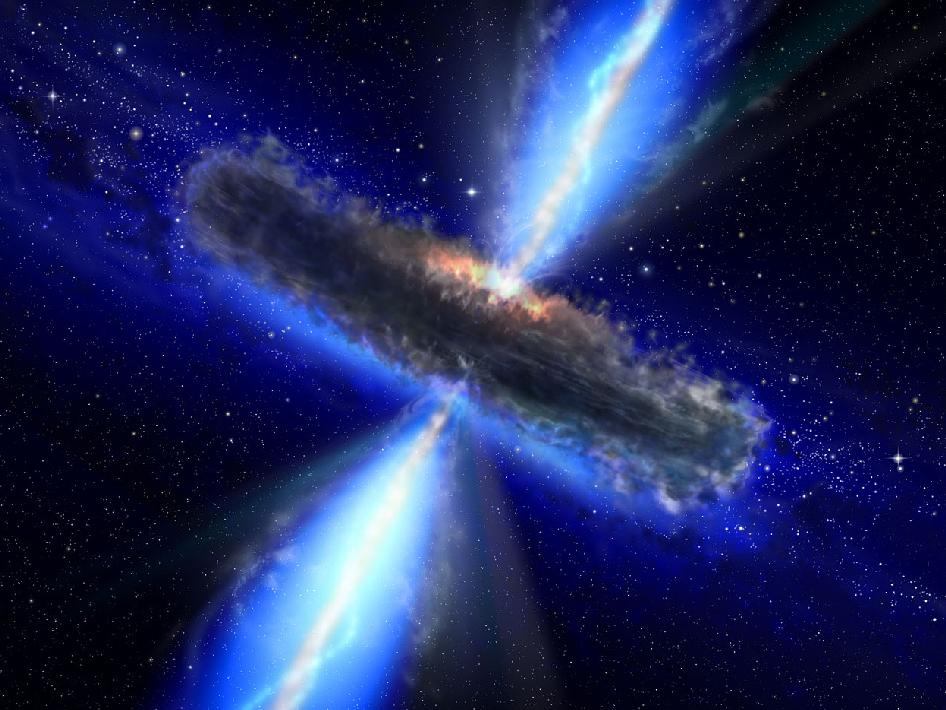|
Black Holes and Quasars |
|
This artist's concept illustrates
a quasar, or feeding black hole, similar to APM
08279+5255, where astronomers
discovered huge amounts of water vapor. Gas and
dust likely form a torus
around the central black hole, with clouds of
charged gas above and below.
X-rays emerge from the very central region,
while thermal infrared radiation
is emitted by dust throughout most of the torus.
While this figure shows
the quasar's torus approximately edge-on, the
torus around APM 08279+5255
is likely positioned face-on from our point of
view. Full
Size
Image
Astronomers Find Largest, Most Distant Reservoir of Water Two teams of astronomers have discovered the largest and farthest reservoir of water ever detected in the universe. The water, equivalent to 140 trillion times all the water in the world's ocean, surrounds a huge, feeding black hole, called a quasar, more than 12 billion light-years away. "The environment around this quasar is very unique in that it's producing this huge mass of water," said Matt Bradford, a scientist at NASA's Jet Propulsion Laboratory in Pasadena, Calif. "It's another demonstration that water is pervasive throughout the universe, even at the very earliest times." Bradford leads one of the teams that made the discovery. His team's research is partially funded by NASA and appears in the Astrophysical Journal Letters. A quasar is powered by an enormous black hole that steadily consumes a surrounding disk of gas and dust. As it eats, the quasar spews out huge amounts of energy. Both groups of astronomers studied a particular quasar called APM 08279+5255, which harbors a black hole 20 billion times more massive than the sun and produces as much energy as a thousand trillion suns. Astronomers expected water vapor to be present even in the early, distant universe, but had not detected it this far away before. There's water vapor in the Milky Way, although the total amount is 4,000 times less than in the quasar, because most of the Milky Way’s water is frozen in ice. Water vapor is an important trace gas that reveals the nature of the quasar. In this particular quasar, the water vapor is distributed around the black hole in a gaseous region spanning hundreds of light-years in size (a light-year is about six trillion miles). Its presence indicates that the quasar is bathing the gas in X-rays and infrared radiation, and that the gas is unusually warm and dense by astronomical standards. Although the gas is at a chilly minus 63 degrees Fahrenheit (minus 53 degrees Celsius) and is 300 trillion times less dense than Earth's atmosphere, it's still five times hotter and 10 to 100 times denser than what's typical in galaxies like the Milky Way. Measurements of the water vapor and of other molecules, such as carbon monoxide, suggest there is enough gas to feed the black hole until it grows to about six times its size. Whether this will happen is not clear, the astronomers say, since some of the gas may end up condensing into stars or might be ejected from the quasar. Bradford's team made their observations starting in 2008, using an instrument called "Z-Spec" at the California Institute of Technology’s Submillimeter Observatory, a 33-foot (10-meter) telescope near the summit of Mauna Kea in Hawaii. Follow-up observations were made with the Combined Array for Research in Millimeter-Wave Astronomy (CARMA), an array of radio dishes in the Inyo Mountains of Southern California. The second group, led by Dariusz Lis, senior research associate in physics at Caltech and deputy director of the Caltech Submillimeter Observatory, used the Plateau de Bure Interferometer in the French Alps to find water. In 2010, Lis's team serendipitously detected water in APM 8279+5255, observing one spectral signature. Bradford's team was able to get more information about the water, including its enormous mass, because they detected several spectral signatures of the water. Other authors on the Bradford paper, "The water vapor spectrum of APM 08279+5255," include Hien Nguyen, Jamie Bock, Jonas Zmuidzinas and Bret Naylor of JPL; Alberto Bolatto of the University of Maryland, College Park; Phillip Maloney, Jason Glenn and Julia Kamenetzky of the University of Colorado, Boulder; James Aguirre, Roxana Lupu and Kimberly Scott of the University of Pennsylvania, Philadelphia; Hideo Matsuhara of the Institute of Space and Astronautical Science in Japan; and Eric Murphy of the Carnegie Institute of Science, Pasadena. Funding for Z-Spec was provided by the National Science Foundation, NASA, the Research Corporation and the partner institutions. Caltech manages JPL for NASA. More
information about
JPL is online at http://www.jpl.nasa.gov .
2011-223 SOURCE: http://www.nasa.gov/topics/universe/features/universe20110722.html |
|
| FAIR USE NOTICE: This page contains copyrighted material the use of which has not been specifically authorized by the copyright owner. Pegasus Research Consortium distributes this material without profit to those who have expressed a prior interest in receiving the included information for research and educational purposes. We believe this constitutes a fair use of any such copyrighted material as provided for in 17 U.S.C § 107. If you wish to use copyrighted material from this site for purposes of your own that go beyond fair use, you must obtain permission from the copyright owner. | |
|
|

